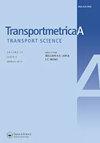利用车辆连接性和自主性,利用强化学习缓解公路瓶颈拥堵
IF 3.1
2区 工程技术
Q2 TRANSPORTATION
引用次数: 0
摘要
自动化和互联平台在管理包括瓶颈在内的公路交通拥堵方面具有巨大潜力。速度协调(SH)是其中一个平台,是一种主动交通管理(ATM)策略,通过调整上游交通速度来实时解决流量中断问题。然而,SH有其局限性,包括需要支持不可移动且覆盖范围有限的道路基础设施;无力:无力实施超出其范围的控制;以及对人类驾驶员依从性的依赖。这些问题可以通过利用联网和自动驾驶汽车(cav)来解决,这些汽车可以收集信息并沿其轨迹执行控制,而无需考虑驾驶员的意识或依从性。为了实现这一目标,本研究利用强化学习来提出CAV控制模型,以实现有效的速度协调。结果表明,即使在低市场渗透率的情况下,自动驾驶汽车也能在更大程度上显著缓解交通拥堵瓶颈。本文章由计算机程序翻译,如有差异,请以英文原文为准。
Leveraging vehicle connectivity and autonomy for highway bottleneck congestion mitigation using reinforcement learning
Automation and connectivity based platforms have great potential for managing highway traffic congestion including bottlenecks. Speed harmonisation (SH), one of such platforms, is an Active Traffic Management (ATM) strategy that addresses flow breakdown in real-time by adjusting upstream traffic speeds. However, SH has limitations including the need for supporting roadway infrastructure that is immovable and has limited coverage; the inability to enact control beyond its range; and the dependence on human driver compliance. These issues could be addressed by leveraging connected and automated vehicles (CAVs), which can collect information and execute control along their trajectories, irrespective of drivers’ awareness or compliance. In addressing this objective, this study utilises reinforcement learning to present a CAV control model to achieve efficient speed harmonisation. The results suggest that even at low market penetration, CAVs can significantly mitigate traffic congestion bottlenecks to a greater extent compared to traditional SH approaches.
求助全文
通过发布文献求助,成功后即可免费获取论文全文。
去求助
来源期刊

Transportmetrica A-Transport Science
TRANSPORTATION SCIENCE & TECHNOLOGY-
CiteScore
8.10
自引率
12.10%
发文量
55
期刊介绍:
Transportmetrica A provides a forum for original discourse in transport science. The international journal''s focus is on the scientific approach to transport research methodology and empirical analysis of moving people and goods. Papers related to all aspects of transportation are welcome. A rigorous peer review that involves editor screening and anonymous refereeing for submitted articles facilitates quality output.
 求助内容:
求助内容: 应助结果提醒方式:
应助结果提醒方式:


